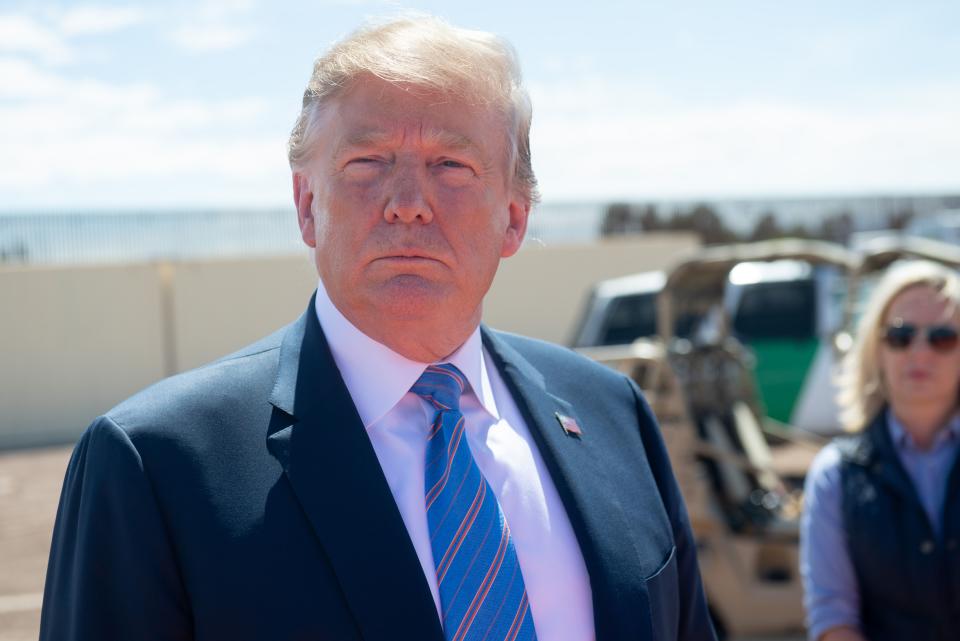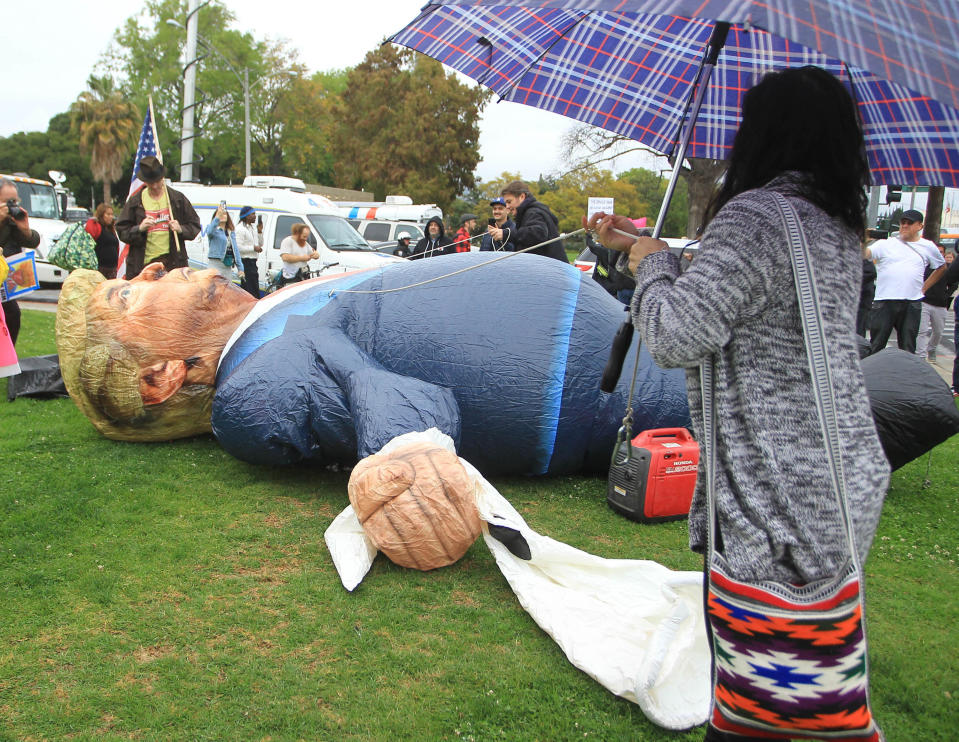California's war with Trump is destroying America
Who’s in charge? Donald Trump or California?
There’s never been any love lost between the president and the Golden State, but now what had been a smoldering feud has become an all-out war. The implications are huge not just for California, but for other states, and in fact, for the very state of our union.
I’ll explain about the big picture, but first, about California.
As you may have heard, Trump and California have punched and counter-punched each other this week over California’s auto emission standards, which are tougher than federal ones, even though automakers—Ford (F), BMW (BMW.DE), Volkswagen (VOW.DE) and Honda (HMC)—have sided with the Californians.
The Trump Administration is revoking California’s Federal Waiver on emissions in order to produce far less expensive cars for the consumer, while at the same time making the cars substantially SAFER. This will lead to more production because of this pricing and safety......
— Donald J. Trump (@realDonaldTrump) September 18, 2019
Governor Gavin Newsom and his administration aren’t shying away from the battle. “This is the fight of a lifetime for us,” said Mary Nichols, the chairwoman of the California Air Resources Board. “I believe we will win.” Twenty-two other states have joined California (an important point here.) And the legal wrangling is expected to last months if not years and could reach the Supreme Court.
#Breaking: Just filed our 60th lawsuit against the Trump Administration over its attempt to trample our authority on clean car standards. Our coalition today is 24 AGs strong with LA and NYC joining us. #SaveCleanCars #ClimateAction https://t.co/fVGZzqx12S
— Xavier Becerra (@AGBecerra) September 20, 2019
That’s just the latest battle. The president and California are engaging on dozens of other legal fronts, including over laws governing the census, immigration and health care.
But even more than that, the California v. Trump tussle is emblematic of a bigger conflict playing out across the country right now, a growing power struggle between the states and the federal government. At issue is which entity has legal authority over everything from gun owner rights to marijuana.
The implications for business and investors are massive. Imagine a country with 50 sets of regulations and standards across every industry. We’re not close to that yet, but the trend in our union at this point is moving clearly towards disunion.

With the election of Trump, we’re seeing a major reset
I’ll delve into that more, but first some important historical context. Defining the power of the states versus the federal government has vexed our country since its inception. Who holds sway over taxation and education for instance has divided our nation, and of course the Civil War was fought over southern states wanting to maintain slavery.
This question, however, really began with a Revolutionary War soldier’s unhappy homecoming.
A veteran of Bunker Hill and other battles, Daniel Shays returned to western Massachusetts wounded, unpaid and in debt—along with thousands of others. Feeling grossly maligned, Shays organized an armed revolt. The army had been disbanded and our nascent federal government had no funds, so merchants in eastern Massachusetts raised a militia on their own to fight Shays and his rebels. In January 1787, Shays attacked a federal armory in Springfield, where he was repulsed, with four of his men killed and 20 wounded. The rebellion was quelled the next month in a bitter snowstorm and Shays died in 1825, his lot little improved by what is called Shays’ Rebellion.
But Shays’ Rebellion had huge consequences for America. It highlighted the weakness of the federal government under the Articles of Confederation and inspired the creation of the U.S. Constitution in 1789 under a Federalist system with its signature division of power between the states and the federal government. Exactly how much power each side should have, however, wasn’t explicitly spelled out and has been a source of friction ever since.
After the Civil War, advocates of states’ rights consisted mostly of conservative southern Democrats defending Jim Crow laws. Later Republicans joined this camp to push back against laws prohibiting mining and drilling for oil on federal lands for instance. Texas—once an independent nation (as we are oft-reminded by its citizens)—has been a states’ rights bastion, which has even extended to include a sometimes sizable secessionist movement.
But with the election of President Trump we are seeing a major reset, as suddenly liberals and blue states become states’ righters, in opposition to new conservative federal mandates and laws.
States resisting Trump
New York state took the lead early in Trump’s term, when the state pushed back against Trump’s immigration policies. Massachusetts attorney general Maura Healy has filed some 43 lawsuits against Trump administration policies or laws including the border wall with Mexico, contraception funding, workplace injuries and the Affordable Care Act. (There’s also a proposed Massachusetts bill, which would require presidential candidates to disclose their tax returns. Wonder who that’s directed towards?)
To be sure though, California has become the epicenter of the states’ resistance to Trump. Not to be outdone by an East Coaster, California Attorney General Xavier Becerra has filed 60 lawsuits and counting against the Feds. “We didn’t become the fifth-largest economy in the world by sitting back and spectating,” Becerra told the San Francisco Chronicle.
Sometimes the action gets tricky to follow. In a somewhat counterintuitive assertion of states’ rights, California recently took the lead in striking a blow against the gig economy by ruling that some drivers of ride-sharing giants Lyft and Uber are in fact employees. Surprising since both Lyft and Uber are headquartered in San Francisco.
Then there’s marijuana, which though still illegal on the federal level, is now OK’d for all types of use in 11 states. It’s made for some strange politicking. Former U.S. Attorney General Jeff Sessions, long a stalwart of states’ rights, was very much against letting states decide on this particular issue. As for Trump and weed, he doesn’t seem to care much one way or the other.
But the larger point is that states’ rights has become a liberal thing. And that’s pretty strange for someone of my generation. Still, while this new blue states’ rights movement has all the momentum right now, conservative anti-Federalism is by no means dead.

Conflict over states’ rights is ‘getting more intense’
Couple both of those strains with years of gridlock in Washington and I think we are beginning to see the emergence of a new era in the delicate balance of Federalism. In short, power is shifting to the states. I don’t think we’re heading straight to a European Union system—which is itself coming apart to a degree—but the trend is not the United States of America’s friend.
“Whenever there’s a Democratic president, Republican states push for more autonomy. Whenever there’s a Republican president, Democratic states push for more autonomy,” says Joachim Klement, head of investment research at Fidante Partners, trustee of the CFA Institute Research Foundation, and author of “Red States, Blue States: Two Economies, One Nation.” But Klement notes that things are in fact “getting more intense.”
No doubt.
“It concerns me a lot of political polarization and one-party rule you have in more and more states, be it Democrat and Republican means disparities between states are only getting bigger,” Klement continues. “Polarization in Washington translates to polarization at the state level, and seeps back into politics, that’s a dangerous development.”
And of course to business people this is anathema. One of the greatest societal and economic strengths of this country is our rule of law, which in most cases is one rule of law. Americans accept legal heterogeneity when it comes to say speed limits and tax rates. Yet despite some crazy blue laws, our country functions because it is a union.
This new tilt, empowering states at the expense of the federal government, might feel good for some of the people some of the time, but it sure doesn’t bode well for all of the people all of the time.
This article was featured in a special Saturday edition of the Morning Brief on September 21, 2019. Get the Morning Brief sent directly to your inbox every Monday to Friday by 6:30 a.m. ET. Subscribe
Andy Serwer is editor-in-chief of Yahoo Finance. Follow him on Twitter: @serwer.
Read more:
Apple and Disney split, while AT&T gets it from all sides
Facebook's Zuckerberg and Sandberg are this involved with the company's content issues
Negative interest rates are coming and they are downright terrifying


